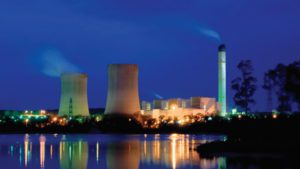The bad news for the solar industry just keeps coming this week, with the announcement that US outfit Solar Trust, a 70-percent owned subsidiary of Germany’s already-bankrupt Solar Millennium, has filed for bankruptcy protection. This is a particularly tough blow for the American solar industry, because it means that the already struggling 1,000MW Blythe Solar Power Project in Blythe, California – the world’s largest solar power project, of which Solar Trust holds the rights – is in deeper trouble. Wall Street Journal reports that Solar Trust filed for Chapter 11 bankruptcy protection in Delaware on Monday after its German majority owner stopped putting money into the company. The paper says the financial pipeline was cut short before engineers could begin operating the Blythe plant, a 1,000MW system which the company claims has the capacity to power 300,000 homes.
As Renewable Energy World reports, the Blythe project, which was originally conceived as a concentrating solar power (CSP) development of unrivaled scale, showed signs of coming undone in August last year, when it was announced that the first 500MW would switch to PV, due to the steep drop in panel prices making it more economically viable. Then, says EarthTechling, another German company, Solarhybrid, stepped in and attempted to buy Solar Trust, but itself moved to declare bankruptcy just two weeks ago. Solar Trust COO Edward Kleinschmidt said in a court filing that the company had already missed two quarterly rent payments on the project, and was unable to make several other payments that were coming due. He added, however, that NextEra Energy Resources has committed to provide some financing and “expressed an interest” in serving as an initial bidder for some assets.
Company officials also said that the bankruptcy case would protect the transmission-rights agreements Solar Trust had made with utilities, without which, said Kleinschmidt, “the Blythe Project would be unable to deliver electricity to market and would be rendered near, if not completely, valueless.” Meanwhile, David Lane, Blythe’s city manager, told Reuters in an interview he remained confident this was not curtains for the plant: “My sense is that with the large investment in what was to have been the world’s largest solar power plant, someone somewhere will buy it and build it.” RE World reports that according to Solar Trust’s website, it has 2,000MW of projects in advanced stages of permitting in California and Nevada.
Q-Cells shares take a tumble
Solar Trust’s bankruptcy announcement came hot on the heels of yesterday’s confirmation from Q-Cells – once the world’s largest solar cell manufacturer – that the German giant would be filing for insolvency sometime today. Bloomberg News reports that the company hit a record low in Frankfurt trading just before it made the announcement, its shares tumbling 41 per cent to 13 euro cents as of the close of trading – a far cry from the manufacturer’s 2005 IPO, when shares sold at €38 apiece. All up, the company’s stock has plunged 77 per cent this year, as it tried to reorganise debt against a backdrop of subsidy cuts and overcapacity.
“At continuously low prices of photovoltaic cells, currently at $0.51 a watt, most manufacturers are bleeding out of cash and Q-Cells has largely depleted its options as the market is not showing signs of recovery anytime soon,” Martin Simonek, a London-based BNEF analyst said. “However, Q-Cells still has something that many Asian companies don’t; a strong brand in Europe,” he said today. “This could play a role, once the price is right.” Bloomberg reports that Solarworld and Conergy are also struggling with competition from Chinese companies, led by Suntech Power, which have expanded capacity, creating a glut in solar panels.
Ceramic welcomes German tariff
ASX-listed Ceramic Fuel Cells has welcomed the introduction in Germany of a capital subsidy for micro power and heating (mCHP) products. Starting April 1, the German Coalition government will subsidise eligible mCHP products that generate up to 20 kilowatts of electricity and meet performance requirements, including a total efficiency of at least 85 per cent. Ceramic says the new tariff will see its BlueGen and integrated mCHP products get a subsidy of €1,800 per unit. This adds to the existing German CHP Law, which requires that 25 per cent of Germany’s electricity generation comes from combined heat and power (small and large scale) by 2020. Ceramic Fuel Cells’ Managing Director Brendan Dow said that, while the subsidy amount was modest, it would add to Germany’s status as a leading market for the Australian company’s clean energy products. “We are actively discussing additional market introduction programs with state and federal governments in Germany,” Dow said. “We look forward to these ongoing consultations to help achieve Germany’s goal of a significant increase in high efficiency power and heat generation.”
UNSW connects with India on solar technology
In local solar news, the University of New South Wales has announced that it will sponsor and host four elite engineering students from India for a solar energy workshop – a project intended to spawn overseas collaborations with Australian students. The idea was spearheaded by Dr Rob Taylor, a mechanical engineer at UNSW who is working on developing next-generation solar thermal energy systems that convert heat from sunlight into electricity – and has been awarded an internal grant from the university’s Faculty of Engineering. The four students, from the Indian Institute of Technology (IIT) Ropar near New Delhi, will be linked up with engineering students at UNSW to work on a range of cutting-edge solar energy projects that will continue by correspondence after the workshop ends.
Dr Taylor sees some interesting solar parallels between India Australia, such as the failure of both countries to take full advantage of their abundant supplies of sunshine. “We wanted to bring these students to UNSW to learn about some of the emerging solar technologies in Australia and to build research partnerships,” says Taylor. “Ultimately, the goal is to get them inspired by renewable energy.” The projects will explore plans for optimised solar powered cooling systems, the development of solar receivers that can withstand extremely high temperatures, and the design of thermal batteries that could be used as an additional energy source for EVs – allowing climate control without compromising travel range.
Other projects will explore ways solar power can be used to more efficiently turn biomass into fuels and to reduce the environmental impact of water desalination. “There are many states in India, especially along the coast line, which experience a shortage of pure water,” says Dr Himanshu Tyagi, the research supervisor from IIT Ropar. “Solar-powered water desalination, if implemented on a large scale, can provide an excellent solution to this problem.” Not to mention the fact that more than half of the India’s population has no access to electricity, adds Tyagi. “For electricity production in rural areas in developing countries, solar energy presents a cheaper alternative.”










